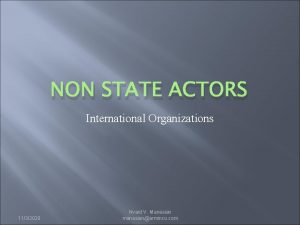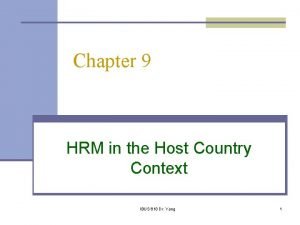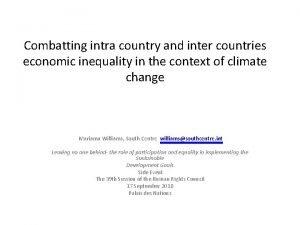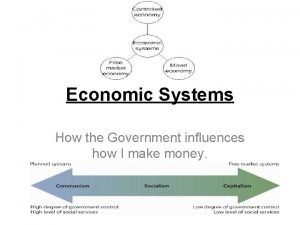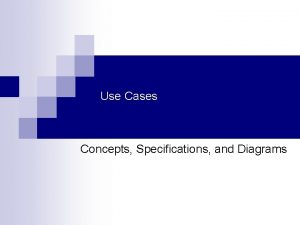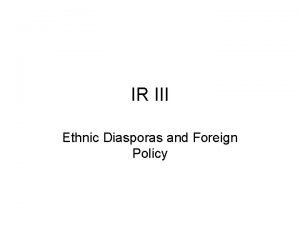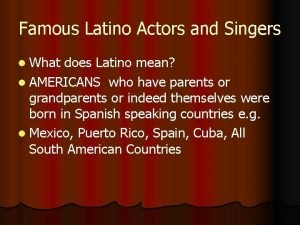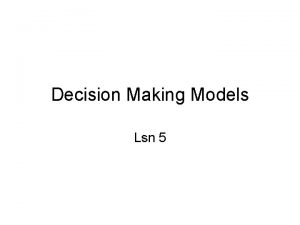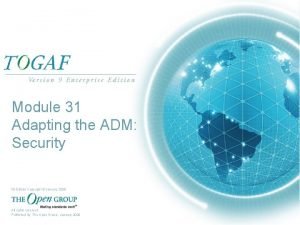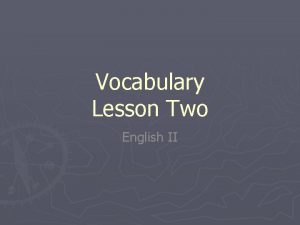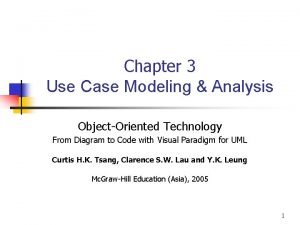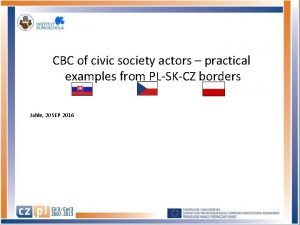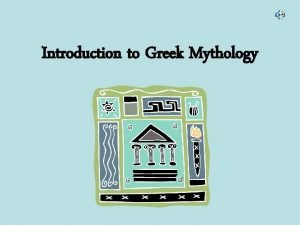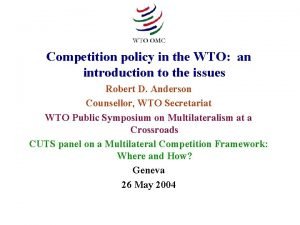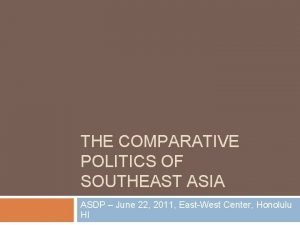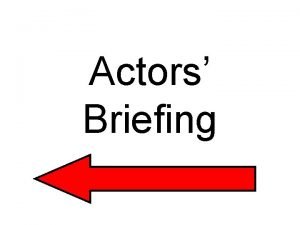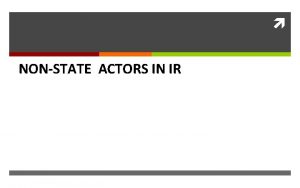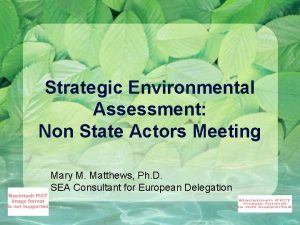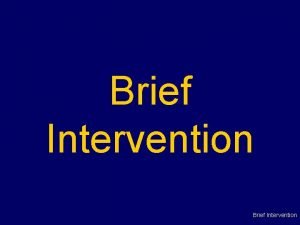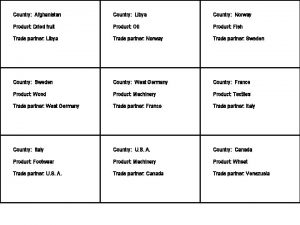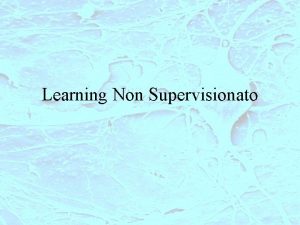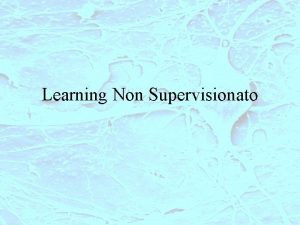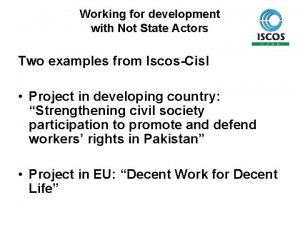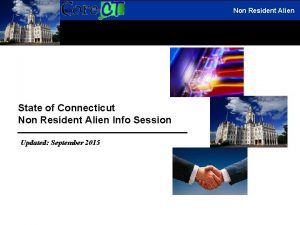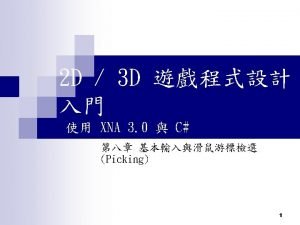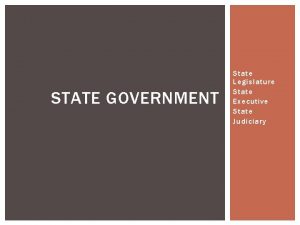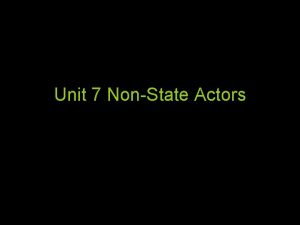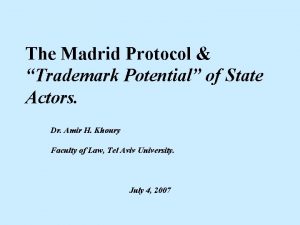Non State Actors in Development In country intervention












































- Slides: 44

Non State Actors in Development In country intervention TONGA Reference: Europe. Aid/135 -761/DD/ACT/TO Stage 1 : Concept Notes

Table of Content • • • Objectives, Priorities and Financial Allocations Eligibility: Actor, Actions, Costs How to Apply: Concept Note Evaluation & Selection Procedure Indicative Timetable List of Annexes & Documents for Information

Objectives , Priorities and Financial Allocations

What is a grant? A grant is a financial contribution by way of donation from the EU in order to finance a programme with specified objectives. It is a payment of a noncommercial nature to a specific beneficiary. Guiding principles ØTransparency (wide publication) ØEqual treatment (complete impartiality) ØNon-cumulation (only one EU grant per project) ØNon-retroactivity (expenditure after signature) ØCo-financing (sharing costs) Exceptionally-NOT for Tongan's CSOs ØNon Profit (grant cannot produce profit)

Objectives of the programme and priority issues Global objective: To strengthen the capacity of civil society to promote inclusive socio-economic development in Tonga It is expected to contribute to strengthening CSOs in being more active in public policy dialogue and advocacy, better able to service the weakest segment of the population and with improved capacity of establishing network and relationship for mutual learning

Specific objectives: • to improve technical and management capacities of civil society promoting the interest of the most vulnerable groups in Tonga, with particular focus on youth, women and people with disabilities as well as other marginalised groups. • to support civil society actions raising awareness on the rights and needs of marginalised and vulnerable groups of the population and enhancing their voice and participation in decision making processes.

Priorities • Small scale development, advocacy activities, accordingly to needs identified by communities (economic development, health, education, capacity building etc. ) • Supporting CSOs already involved in capacity strengthening activities (strengthening of organisational and implementing capacity, improving the accountability of the sector). • Particular attention on activities mainstreaming human rights issues and targeting most vulnerable groups esp. women and youth participation and empowerment.

Financial allocation The overall indicative amount is € 238, 000 (the EU may not award all available funds). Size of grants must fall between: • minimum amount: € 79, 000 • maximum amount: € 119, 000 The EU only funds a % of total eligible costs of the action: ü European NSA: 75% of the total eligible costs of the action*. ü Tongan NSA: Exceptionally for Tongan applicants only, the grant may cover 100% of the total eligible costs of the Action, to take into account the reduced cofinancing capacity of the beneficiaries. *The balance between the total cost of the action and the amount requested from the EU must be financed from sources other than the European Union Budget or the European Development Fund

Eligibility Criteria

ELIGIBILITY CRITERIA THERE ARE 3 SET OF ELIGIBILITY CRITERIA The Actor • Applicant • Its Co-Applicant ( and if any its affiliated entities) See guidelines for eligibility criteria The Action • Actions for which a grant may be awarded See guidelines for eligible actions The Costs • types of cost that may be taken into account in setting the amount of the grant See guidelines for eligible and non eligible costs

Eligibility Criteria 1.

1. THE ACTOR: Applicants (and co-applicant(s)) (1)In order to be eligible for a grant, the applicant must: • be a legal person and be non-profit-making and • be a specific type of organisation such as non-State actor ( see next slide), • be established* in a Member State of the European Union or in Tonga. • be directly responsible for the preparation and management of the action with the co-applicant(s) and affiliated entity(ies), not acting as an intermediary and To be determined on the basis of the organisation’s statutes, which should demonstrate that it has been established by an instrument governed by the national law of the country concerned and that its head office is located in an eligible country *

(2) The potential applicant may not participate in the Call or be awarded grants if it is in any of the situations: -bankrupt or being wound up, affairs administered by the court, entered into arrangement with creditors, suspended business activities, subject of proceedings concerning those matters, in any analogous situation arising from similar procedure in national registration -persons having powers of representation and decision making and control have been convicted of an offense concerning their professional conduct -guilty of grave professional misconduct - not in compliance with their obligations relating to payment of social security contributions subject of fraud, corruption, criminal organisations, money laundering or any other illegal activities - currently subject to an administrative penalty In Part A, section 3 of the grant application form (‘Declaration by the applicant’), the applicant must declare that the applicant himself, the co-applicant(s) and affiliated entity(ies) are not in any of these situations.

Remember If awarded the Grant contract, the applicant will become the Beneficiary identified as the Coordinator. The Coordinator is the main interlocutor of the EU, represents and acts on behalf of any other co-beneficiary (if any) and coordinate

*Type of NSAs eligible Media, nongovernmental associations , independent foundations, independent political foundations Teaching, cultural, research and scientific orgs, universities, churches , religious associations, Organisations representing economic and social interests, fighting corruption and fraud, promoting good governance, civil rights Organisations representing indigenous peoples, representing national and/or ethnic minorities Organisations representing economic and social interests, fighting corruption and fraud & promoting good governance, civil rights, combating discrimination, Local traders' and citizens' groups, cooperatives, trade unions, Local organisations/networks involved in decentralised regional cooperation and integration, consumer organisations, women's and youth organisations,

The Actor: Co-applicant(s) Who is a co- • Co-applicant(s) participate in designing and implementing the action, and the costs they incur are eligible in the same way as those incurred by the applicant? Who is eligible as co-applicant? Remember • Co-applicant(s) must satisfy the eligibility criteria as applicable to the applicant himself. In addition the following are however also eligible: • NSAs or association of NSAs from a Pacific ACP country. • Local Authorities or an Association of Local Authorities established in Tonga or a Pacific ACP country or a Member State of the European Union (constituted in accordance with the legislation in force of the country or an association of Local Authorities registered in the country). • Co-applicant(s) are COMPULSORY for this call for proposal • Co-applicant(s) must sign the Mandate in Part B section 4 of the grant application form. • Co-applicant(s) will become beneficiaries in the Action (together with the Coordinator)

the Actor: Affiliated entities: What is an affiliated entity? Does this apply to your organisations? An organisation having a structural link with applicants (esp. legal or capital link) encompassing 2 notions: (i) (ii) Control on the annual financial statements, consolidated financial statements and related reports of certain types of undertakings Membership, i. e. the beneficiary is legally defined as a e. g. network, federation, association in which the proposed affiliated entities also participate or the beneficiary participates in the same entity.

What is not an affiliated entity? The following are NOT considered entities affiliated to a beneficiary: • Entities that have entered into a (procurement) contract or subcontract with a beneficiary, act as concessionaires or delegates for public services for a beneficiary, • Entities that receive financial support from the beneficiary, • Entities that cooperate on a regular basis with the beneficiary on the basis of a memorandum of understanding or share some assets, • Entities that have signed a consortium agreement under the grant contract.

Associates and Contractors The following entities are not applicant(s) nor affiliated entity(ies) and do not have to sign the "mandate" or "affiliated entities' statement Associates Play a real role in the action but may not receive funding from the grant, with the exception of per diem or travel costs. Associates do not have to meet the eligibility criteria as the applicant but must be mentioned in the Application form Contractors The grant beneficiaries and their affiliated entities are permitted to award contracts. Associates or affiliated entity(ies) can NOT be also contractors in the project. Contractors are subject to the procurement rules set out in Annex IV to the standard grant contract.

Eligibility criteria 2.

2. THE ACTION: Eligible actions An action is composed of a set of activities. Duration: The initial planned duration of an action may not exceed 36 months. Sectors or themes: • The thematic focus of the present call for proposals is set in section ''Objectives of the Programme'' of the present Guidelines. • Actions presented within the framework of the present call can address more than one of the specific objectives mentioned in the present Guidelines. Location: • Actions must take place in one or more of the following countries: Tonga.

Types of activity ( some examples and not exhaustive !) A set of activities has defined operational objectives, target groups and planned, tangible outcomes, within a limited timeframe, in line with the proposal's priorities and objective addressing capacity development of CSOs, including transfer of knowledge among organisations enhancing voice and participation of vulnerable and marginalised groups providing improved services to vulnerable groups raising awareness, advocacy and public policy research supporting advocacy and participatory planning, implementation, monitoring and evaluation

Do not forget about these principles ! increased participation of the poorest sections of the population in the policy making processes including marginalized and vulnerable groups that do not have access to Government services, increased interaction between state and NSA (policy dialogue/ playing an oversight role) increased NSA participation in poverty reduction and sustainable development strategies,

Types of actions The following types of actions are ineligible: • actions concerned only or mainly with individual sponsorships for participation in workshops, seminars, conferences ; • actions concerned only or mainly with individual scholarships for studies or training courses; • actions which consist exclusively or primarily in capital expenditure, e. g. land, buildings, equipment and vehicles, • actions which discriminate against individuals or groups of people on grounds of their gender, sexual orientation, religious beliefs or lack of them, or their ethnic origin; • actions supporting political parties; • actions including proselytism; • microfinance activities

A particular action: Financial support to third parties • Applicants may propose financial support to 3 rd parties in order to help achieve the objectives but may not be the main purpose of the action. • The max amount of financial support per 3 rd party is EUR 60 000. • Applicants should define mandatorily in the grant application form: (i) objectives and results to be obtained with the financial support (ii) different types of activities eligible for financial support, on the basis of a fixed list (iii) types of persons/ categories of persons which may receive financial support (iv) criteria for selecting these entities and giving the financial support (v) criteria for determining the exact amount of financial support for each third entity, and (vi) the maximum amount which may be given.

Number of applications and grants per applicants • The applicant may not submit more than one (1) application(s) under this Cf. Ps. • The applicant may not be awarded more than one (1) grant(s) under this Cf. Ps. • The applicant may not be a co-applicant or an affiliated entity in another application at the same time. • A co-applicant may submit more than one 1 application(s) under this Cf. Ps. • A co-applicant may be awarded more than one 1 grant(s) under this Cf. Ps. • A co-applicant may not be the applicant or an affiliated entity in another application at the same time.

Eligibility criteria 3.

3. THE COST: Eligibility of costs Eligible costs may be based on any or a combination of the following forms: • actual costs incurred • one or more simplified cost options: 1. unit costs: covering all or certain specific categories of eligible costs which are clearly identified in advance by reference to an amount per unit. 2. lump sums: covering in global terms all or certain specific categories of eligible costs which are clearly identified in advance. 3. flat-rate financing: covering specific categories of eligible costs which are clearly identified in advance by applying a percentage fixed ex ante. No need to provide a breakdown of costs in the concept note

$ ELIGIBILITY OF COSTS Eligible indirect costs (overhead) Direct Eligible Costs (DEC) Contingency Reserve: Max 5% of Total eligible costs ELIGIBLE COSTS Admin Cost: Max 7% of Total eligible costs TAX With proof that it can not be reclaimed 29

Ineligible costs The following costs are not eligible: • debts and debt service charges (interest); • provisions for losses or potential future liabilities; • costs declared by the Beneficiary(ies) and financed by another action or work programme receiving a Union (including through EDF) grant; • purchases of land or buildings, except where necessary for the direct implementation of the action, in which case ownership must be transferred to the final beneficiaries and/or local Beneficiary(ies), at the latest at the end of the action; • currency exchange losses

How to Apply Register in Pador Prepare your concept note Send your application ( Where, How and When)

PADOR • • • Phase 1, concept note: Registration in PADOR is compulsory for applicants Phase 2, full proposal: Registration in PADOR is compulsory for all preselected applicants, co-applicant(s) and all their affiliated entity(ies). ] PADOR is an on-line database in which organisations register and update their data regularly, through the Europe. Aid website: http: //ec. europa. eu/europeaid/work/onlineservices/pador/index_en. htm Before starting to register your organisation in PADOR, please read the ‘Quick guide’ on the website. It explains the registration process. It is strongly recommended to register in PADOR when you start drafting your proposal and not to wait until just before the deadline of submission. On the paper version of the proposal you must give your Europe. Aid ID (ID). To get this ID, your organisation must enter PADOR to register, save and ‘sign’ certain obligatory data (the fields shown in orange on each screen) and the related documents (see section 2. 4). However, if it is impossible for the organisation to register in PADOR, it must submit a justification proving that this impossibility is general and beyond the control of the applicant and/or its affiliated entity(ies). In such cases, ‘PADOR off-line form attached to these Guidelines and send it by the submission deadline, together with the application, to the address indicated in sections 2. 2. 2 and 2. 2. 6. The registration in PADOR will then be carried out by the European Commission service in charge of the Call for Proposals. If, at a later stage, the organisation wishes to update its data itself, it will have to send an access request to the PADOR helpdesk at: Europeaid-pador@ec. europa. eu

Concept Note content • Applications must be submitted in accordance with the Concept Note instructions in the Grant Application Form annexed to these Guidelines (Annex A) and must apply in English. • Only provide an estimate of the amount of contribution requested. • Any error or major discrepancy related to the points listed in the Concept Note instructions may lead to the rejection of the Concept Note. • Clarifications will only be requested when information provided is not sufficient to conduct an objective assessment. • Hand-written Concept Notes will not be accepted. • Please note that only the Concept Note form will be evaluated. It is therefore of utmost importance that this document contains ALL relevant information concerning the action. No additional annexes should be sent.

Where and how to send the Concept Notes • The Concept Note together with its relating Checklist and Declaration by the applicant (Part A sections 2 and 3 of the grant application form) must be submitted in one original and two (1) copies in A 4 size, each bound. • An electronic version of the Concept Note must also be submitted on a CDRom, along with the paper version, in a sealed envelope as described below. The electronic file must contain exactly the same application as the paper version enclosed. • The outer envelope must bear the reference number and the title of the call for proposals, together with the full name and address of the applicant, and the words ''Not to be opened before the opening session''. • Concept Notes must be submitted in a sealed envelope by registered mail, private courier service or by hand-delivery (a signed and dated certificate of receipt will be given to the deliverer) to the address below: Postal address: European Union for the Pacific, Private Bag, G. P. O. Suva, FIJI Hand delivery: European Union for the Pacific 360 Victoria parade, level 4 FDB Building, Suva, FIJI Concept Notes sent by any other means (e. g. by fax or by e-mail) or delivered to other addresses will be rejected.

When to Submit the Concept Notes • • Deadline for the submission of Concept Notes is 16 June 2014 as evidenced by the date of dispatch, the postmark or the date of the deposit slip. In the case of hand-deliveries, the deadline for receipt is at 5 pm Tonga. Time (4 pm in Fiji), as evidenced by the signed and dated receipt. Any Concept Note submitted after the deadline will be rejected. However, for reasons of administrative efficiency, the EU may reject any Concept Note sent in due time but received after the effective date of approval of the Concept Note evaluation Questions may be sent by e-mail no later than 21 days before the deadline for the submission of Concept Notes to the address(es) below, indicating clearly the reference of the Call for Proposals: E-mail address: delegation-fiji-eidhr@eeas. europa. eu Replies will be given no later than 11 days before the deadline for submission. To ensure equal treatment of applicants, the EU cannot give a prior opinion on the eligibility of applicants, affiliated entity(ies), an action or specific activities. Frequently Asked Questions (FAQs) will be published on the Europe. Aid website https: //webgate. ec. europa. eu/europeaid/onlineservices/index. cfm? do=publi. welcome and on the EU Delegation for the Pacific website http: //eeas. europa. eu/delegations/fiji/index_en. htm. It is therefore advisable to consult the abovementioned website regularly in order to be informed of the questions and answers published. All questions related to PADOR registration should be addressed to the PADOR help desk

What comes after?

EVALUATION AND SELECTION OF APPLICATIONS • Applications will be examined and evaluated by the EU with the possible assistance of external assessors. All actions submitted by applicants will be assessed according to the following steps and criteria. • If the examination of the application reveals that the proposed action does not meet the eligibility criteria, the application will be rejected on this sole basis.

EVALUATION STEP 1: OPENING & ADMINISTRATIVE CHECKS AND CONCEPT NOTE EVALUATION The following will be assessed: • Compliance with the submission deadline. If the deadline has not been met, the application will automatically be rejected. • The Concept Note satisfies all the criteria specified in points 1 -5 of the Checklist (Section 2 of Part A of the grant application form). If any of the requested information is missing or is incorrect, the application may be rejected on that sole basis and the application will not be evaluated further. • The Concept Notes that pass the first administrative check will be evaluated on the relevance and design of the proposed action. • The Concept Note will receive an overall score out of 50 using the breakdown in the evaluation grid below. The evaluation will also check on compliance with the instructions on the Concept Note, which can be found in Part A of the Application Form. • The evaluation criteria are divided into headings and subheadings. Each subheading will be given a score between 1 and 5 as follows: 1 = very poor; 2 = poor; 3 = adequate; 4 = good; 5 = very good.

1. Relevance of the action 1. 1 How relevant is the proposal to the objectives and priorities of the Call for Proposals? * 1. 2 How relevant to the particular needs and constraints of the target country(ies) or region(s) is the proposal (including synergy with other EU initiatives and avoidance of duplication)? 1. 3 How clearly defined and strategically chosen are those involved (final beneficiaries, target groups)? Have their needs been clearly defined and does the proposal address them appropriately? 1. 4 Does the proposal contain specific added-value elements, such as environmental issues, promotion of gender equality and equal opportunities, needs of disabled people, rights of minorities and rights of indigenous peoples, or innovation and best practices [and the other additional elements indicated under 1. 2. of these Guidelines]? 2. Design of the action 2. 1 How coherent is the overall design of the action? In particular, does it reflect the analysis of the problems involved, take into account external factors and relevant stakeholders? 2. 2 Is the action feasible and consistent in relation to the objectives and expected results? TOTAL SCORE Sub-score 30 5 x 2** 5 x 2* 5 5 Sub-score 5 x 2** 20 5 x 2** 50

1. 2. 3. • Only the Concept Notes with a score of at least 30 will be considered for pre-selection. • The number of Concept Notes will be reduced, taking account of the ranking, to the number of Concept Notes whose total aggregate amount of requested contributions is equal to 200% of the available budget for this Call for Proposals. The amount of requested contributions of each concept note will be based on the indicative financial envelopes for each lot. • After the evaluation of Concept Notes, the EU will send letters to all applicants, indicating whether their application was submitted by the deadline, informing them of the reference number they have been allocated, whether the Concept Note was evaluated and the results of that evaluation. The pre-selected applicants will subsequently be invited to submit full applications.

Indicative timetable Information meeting Deadline for requesting any clarifications from the EU Last date on which clarifications are issued by the EU Deadline for submission of Concept Notes Information to applicants on opening, administrative checks and concept note evaluation (Step 1) Invitations to submit Full Application Form Deadline for submission of Full Application Form Information to applicants on the evaluation of the Full Application Form (Step 2) Notification of award (after the eligibility check) (Step 3) Contract signature DATE 6 May 2014 TIME* 9 am (Tonga Time) 26 th May 5 pm (Tonga Time) 5 June 2014 - 16 June 2014 5 pm (Tonga Time) 18 th July - 21 st July 2014 - 3 rd Sept 2014 - 29 th Sept 2014 - 30 Oct 2014 - Dec 2014* -

LIST OF ANNEXES • DOCUMENTS TO BE COMPLETED • Annex A: Grant Application Form (Word format) • Annex B: Budget (Excel format) • Annex C: Logical Framework (Excel format) • Annex D: Legal Entity Sheet • Annex E: Financial identification form • Annex F: PADOR off Line Form Optional where the total amount of the grants to be awarded under the Cf. Ps is € 100 000 or less. Only applicable where the European Commission is the Contracting Authority or will make the payments under the contracts to be signed. • http: //ec. europa. eu/europeaid/work/onlineservices/pador/dispensat ion_en. htm. Only applicable in centralised calls where PADOR used.

DOCUMENTS FOR INFORMATION Annex G: Standard Grant Contract Annex II: General conditions Annex IV: contract award procedures Annex V: standard request for payment Annex VI: model narrative and financial report Annex H: Daily allowance rates (Per diem), available at the following address: http: //ec. europa. eu/europeaid/work/procedures/implementation/index_en. htm • Annex K: Guidelines/Checklist for assessing Budget & Simplified cost options. • Annex J: Tax regime applicable to grant contracts signed under the call. Useful links: • Project Cycle Management Guidelines • http: //ec. europa. eu/europeaid/multimedia/publications/manu als-tools/t 101_en. htm The implementation of grant contracts - A Users' Guide • http: //ec. europa. eu/europeaid/companion/document. do? chapter. Id=497 • Financial Toolkit http: //ec. europa. eu/europeaid/work/procedures/financialmanagement-toolkit_en. htm • • •

DISCLAIMER The contents of this presentation do not replace the guidelines and application forms which are the only binding documents for the Call !!! 44
 Who are non state actors
Who are non state actors Host country and home country
Host country and home country Intra country vs inter country
Intra country vs inter country Dieu cherche encore des hommes forts lyrics
Dieu cherche encore des hommes forts lyrics Non violent crisis intervention techniques
Non violent crisis intervention techniques Od interventions
Od interventions Rdi relationship development intervention program
Rdi relationship development intervention program State planners in country a met to decide
State planners in country a met to decide State planners in country a met to decide
State planners in country a met to decide Use case with multiple actors
Use case with multiple actors Use case primary and secondary actors
Use case primary and secondary actors Use case primary and secondary actors
Use case primary and secondary actors Include and extend in use case
Include and extend in use case Actors queue
Actors queue What are the forces in the marketing environment
What are the forces in the marketing environment Actors in foreign policy
Actors in foreign policy Use case with multiple actors
Use case with multiple actors Gloria estefan married to emilio estevez
Gloria estefan married to emilio estevez Actors in foreign policy
Actors in foreign policy Use case diagram for hospital management system
Use case diagram for hospital management system Security actors
Security actors Marketing management
Marketing management Italian renaissance actors
Italian renaissance actors Greek theatre masks
Greek theatre masks Why did greek actors wear masks
Why did greek actors wear masks Actors in micro environment
Actors in micro environment The television evangelist faced ignominy when the public
The television evangelist faced ignominy when the public An actor's job is one of artistic selectivity
An actor's job is one of artistic selectivity Staging positions
Staging positions Global health actors
Global health actors Use case description
Use case description Civic actors examples
Civic actors examples Actors in business
Actors in business In what way is thisby's final speech humorous?
In what way is thisby's final speech humorous? Elizabethan theatre history
Elizabethan theatre history Famouse actors
Famouse actors Maori people
Maori people Who are the children of zeus
Who are the children of zeus Actors generator
Actors generator They still haven't found out what caused the accident
They still haven't found out what caused the accident Aspects of development in a country
Aspects of development in a country Liquid state of matter properties
Liquid state of matter properties State to state regionalism
State to state regionalism D ff excitation table
D ff excitation table Good and bad state graphs
Good and bad state graphs
